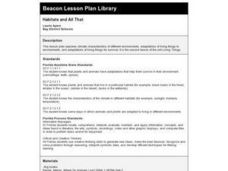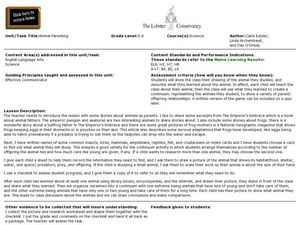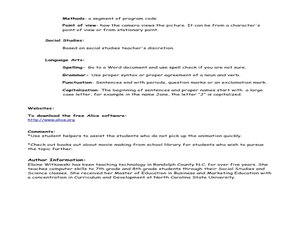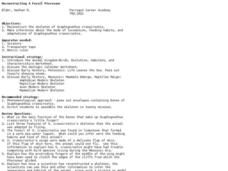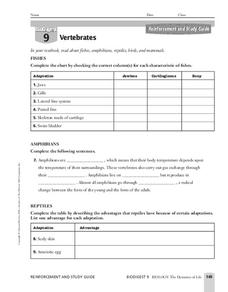Curated OER
How Organisms Live Successfully in Their Environments
Middle schoolers compare the climate and organisms found in different environments, then give examples of how plants and animals adapt to their environment. They design an animal who adapts using camouflage to a made-up environment.
Curated OER
Camouflage
Here is a instructional activity which incorporates ingenious hands-on activities that simulate how many animals use camouflage as a survival technique. This instructional activity clearly outlines how to implement the activities and...
Curated OER
Habitats and All That
First graders read books, complete online explorations and discuss the ways in which animals adapt to their habitats in order to survive. They create accordion books, play matching games and dramatize animal adaptations.
Floyd County Schools
Who Is Hibernating?
Young scientists explore the wintertime behavior of common animals with this presentation on hibernation. Offering clear explanations about the who, what, where, when, and why regarding hibernation, this resource is perfect for primary...
Curated OER
Food Grab
Students analyze animal adaptations. In this animal adaptation lesson plan, students create food-gathering devices. Students design devices that would protect animals or plants from predators.
Alabama Wildlife Federation
Big Fish, Little Fish
Tag, you're eaten! A lesson on predator-prey relationships uses the game freeze tag as a model. Learners become either a predator or prey and play a game of tag as the prey tries to reach areas that house food and shelter. During the...
American Museum of Natural History
What's This? Breathing
Crazy fact: Some animals can survive months without oxygen. An online resource describes some unique ways animals collect oxygen and even live without it for an extended time. Learners read about these special animals and use pop-up...
Howard Hughes Medical Institute
How Animals Use Sound to Communicate
Communication involves the visual, auditory, olfactory, and tactile senses. Scholars observe groups of animals communicating through multiple senses. They note and learn why different species use different senses depending on their...
National Wildlife Federation
Prairie Chicken Pageant
Diminishing habitats is a real concern that is threatening endangered species. Learners examine these concerns by studying the prairie chicken. Groups get a card with characteristics and threats to the species that they turn into skits.
NOAA
Deep-Sea Benthos
Much like a distant planet, the underwater world of deep-sea benthos is strange and largely unknown. How do creatures survive and thrive in such extreme pressure and temperature conditions? Young oceanographers join the crew of Operation...
Curated OER
All Things Science Jeopardy
"Jeopardy"-style PowerPoints are a favorite for learners! This resource covers four categories, and has a ????? category as well. The categories are: animal adaptations, sound, electricity, and Earth. The hints are high-level, and this...
Curated OER
Regents High School Examination: Living Environment 2003
The living environment, from the interior of a cell to the complex relationships among populations, are queried in this final examination. Learners look at air pollution maps, diagrams of cells, population graphs, and drawing of cells....
US Environmental Protection Agency
Carbon Through the Seasons
Meteorologists view an animated video by the Environmental Protection Agency to learn how the carbon cycle works, and then move into groups to analyze and graph actual data of the atmospheric carbon dioxide concentration from Hawaii's...
Howard Hughes Medical Institute
Gorongosa: Making Observations Activity
Do you have young scientists wanting to make new discoveries rather than just completing the same experiments? Young scientists use their observational skills to identify animals and patterns in animal behavior. Through tracking...
Curated OER
Diversity And Adaptations Of Organisms
Eighth graders study how and why animals are classified into eight groups in the animal kingdom. They work together to identify organisms. They use the key to determine the phylum for the included problems.
Curated OER
Animal Camouflage 1
Second graders work in groups and they are asked to line up on either side of the board. They are explained that on the teachers instruction, one student at a time runs to the marked area and brings back the first worm they see. Students...
Curated OER
Animal Parenting
Students analyze parenting instincts. In this parenting instincts instructional activity, students view a drawing of animal they studies and describe what they learned about the animal. Students teach the class about their animal and the...
Curated OER
Creating Animated Overviews in History
Seventh graders explore the attributes of ancient civilizations. In this world history lesson, 7th graders conduct research to create animated movies. Students research ancient Egypt or feudal Japan and follow the provided steps to...
Curated OER
The American Prairie
Learners design an animal. In this prairie lesson, students learn about physical and behavioral adaptation, locate the Great Plains on a map, and design an animal that would be perfectly adapted for life on the prairie. ...
Curated OER
Blue Planet: Frozen Seas
Young scholars study the animals from the Arctic and how they have adapted. In this ocean lesson students create a poster about their given animal and present it to the class.
Curated OER
Reconstructing a Fossil Pterosaur
Learners reconstruct the skeleton of the fossil Scaphognathus crassirostis. In this fossil lesson plan, students discuss the Kingdoms of life, geologic history and the history of the skeletons of species. Learners are given 20 minutes to...
Curated OER
A Walk in the Wild
Fifth graders identify characteristics of animals and their habitat. In this animal science instructional activity, 5th graders read Crinkleroot's Book of Animal Tracking and and Animal Tracks. Students match animal tracks to the correct...
Curated OER
Web of Life - Role-Playing
Learners role-play how organisms adapt to their environment. They play 20 questions with plant and animal habitats. They create a web of life to demonstrate how each plant and animal relies on the other for survival.
Curated OER
Vertebrates
In this vertebrate worksheet, high schoolers review the different adaptations for the 5 groups of vertebrates: birds, mammals, reptiles, amphibians, and fishes. This worksheet has 12 matching, 1 fill in the blank, and 7 short answer...
Other popular searches
- Ocean Animal Adaptations
- Fantasy Animal Adaptations
- Plant and Animal Adaptations
- Animal Adaptations Behaviors
- Animal Adaptations +Wetlands
- Animal Adaptations Wetlands
- Animal Adaptations Eating
- Desert Animal Adaptations
- Animal Adaptations to Cold
- Animal Adaptations and Math
- Oceanic Animal Adaptations
- Animal Adaptations Oceans




